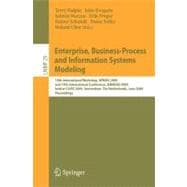
| BPMDS 2009 | |
| Business and Goal Related Drivers | |
| Towards a BPM Success Model: An Analysis in South African Financial Services Organisations | p. 1 |
| A Conceptual Framework for Business Process Redesign | p. 14 |
| Supporting Change in Business Process Models Using Pattern-Based Constraints | p. 27 |
| Eliciting Goals for Business Process Models with Non-Functional Requirements Catalogues | p. 33 |
| A Business Process-IT Alignment Method for Business Intelligence | p. 46 |
| Model-Driven Process Change | |
| Analysis and Validation of Control-Flow Complexity Measures with BPMN Process Models | p. 58 |
| Vertical Alignment of Process Models - How Can We Get There? | p. 71 |
| Ontology-Based Description and Discovery of Business Processes | p. 85 |
| Technological Drivers and IT Services | |
| A Method for Service Identification from Business Process Models in a SOA Approach | p. 99 |
| IT Capability-Based Business Process Design through Service-Oriented Requirements Engineering | p. 113 |
| Minimising Lifecycle Transitions in Service-Oriented Business Processes | p. 126 |
| Technological Drivers and Process Mining | |
| Discovering Business Rules through Process Mining | p. 136 |
| Anomaly Detection Using Process Mining | p. 149 |
| Pattern Mining in System Logs: Opportunities for Process Improvement | p. 162 |
| Compliance and Awareness | |
| Regulatory Compliance in Information Systems Research - Literature Analysis and Research Agenda | p. 174 |
| Actor-Driven Approach for Business Process. How to Take into Account the Work Environment? | p. 187 |
| Towards Object-Aware Process Management Systems: Issues, Challenges, Benefits | p. 197 |
| EMMSAD 2009 | |
| Use of Ontologies | |
| Supporting Ontology-Based Semantic Annotation of Business Processes with Automated Suggestions | p. 211 |
| On the Importance of Truly Ontological Distinctions for Ontology Representation Languages: An Industrial Case Study in the Domain of Oil and Gas | p. 224 |
| UML and MDA | |
| UML Models Engineering from Static and Dynamic Aspects of Formal Specifications | p. 237 |
| MDA-Based Reverse Engineering of Object Oriented Code | p. 251 |
| New Approaches | |
| Integrated Quality of Models and Quality of Maps | p. 264 |
| Masev (Multiagent System Software Engineering Evaluation Framework) | p. 277 |
| ORM and Rule-Oriented Modeling | |
| Transactions in ORM | p. 291 |
| The Orchestration of Fact-Orientation and SBVR | p. 302 |
| Goal-Oriented Modeling | |
| Goal-Directed Modeling of Self-adaptive Software Architecture | p. 313 |
| A Goal Modeling Framework for Self-contextualizable Software | p. 326 |
| Alignment and Understandability | |
| Security and Consistency of IT and Business Models at Credit Suisse Realized by Graph Constraints, Transformation and Integration Using Algebraic Graph Theory | p. 339 |
| Declarative versus Imperative Process Modeling Languages: The Issue of Understandability | p. 353 |
| Enterprise Modeling | |
| The Architecture of the ArchiMate Language | p. 367 |
| Enterprise Meta Modeling Methods - Combining a Stakeholder - Oriented and a Causality-Based Approach | p. 381 |
| Patterns and Anti-patterns in Enterprise Modeling | |
| Organizational Patterns for B2B Environments - Validation and Comparison | p. 394 |
| Anti-patterns as a Means of Focusing on Critical Quality Aspects in Enterprise Modeling | p. 407 |
| Author Index | p. 419 |
| Table of Contents provided by Ingram. All Rights Reserved. |
The New copy of this book will include any supplemental materials advertised. Please check the title of the book to determine if it should include any access cards, study guides, lab manuals, CDs, etc.
The Used, Rental and eBook copies of this book are not guaranteed to include any supplemental materials. Typically, only the book itself is included. This is true even if the title states it includes any access cards, study guides, lab manuals, CDs, etc.